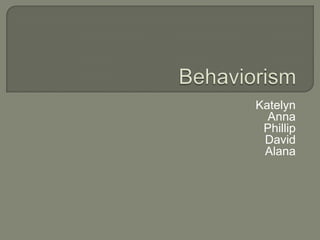Behaviorism
•Descargar como PPTX, PDF•
4 recomendaciones•598 vistas
PowerPoint presentation about Behaviorism.
Denunciar
Compartir
Denunciar
Compartir

Recomendados
Más contenido relacionado
La actualidad más candente
La actualidad más candente (20)
Similar a Behaviorism
Similar a Behaviorism (20)
Último
Mehran University Newsletter is a Quarterly Publication from Public Relations OfficeMehran University Newsletter Vol-X, Issue-I, 2024

Mehran University Newsletter Vol-X, Issue-I, 2024Mehran University of Engineering & Technology, Jamshoro
https://app.box.com/s/7hlvjxjalkrik7fb082xx3jk7xd7liz3TỔNG ÔN TẬP THI VÀO LỚP 10 MÔN TIẾNG ANH NĂM HỌC 2023 - 2024 CÓ ĐÁP ÁN (NGỮ Â...

TỔNG ÔN TẬP THI VÀO LỚP 10 MÔN TIẾNG ANH NĂM HỌC 2023 - 2024 CÓ ĐÁP ÁN (NGỮ Â...Nguyen Thanh Tu Collection
https://app.box.com/s/x7vf0j7xaxl2hlczxm3ny497y4yto33i80 ĐỀ THI THỬ TUYỂN SINH TIẾNG ANH VÀO 10 SỞ GD – ĐT THÀNH PHỐ HỒ CHÍ MINH NĂ...

80 ĐỀ THI THỬ TUYỂN SINH TIẾNG ANH VÀO 10 SỞ GD – ĐT THÀNH PHỐ HỒ CHÍ MINH NĂ...Nguyen Thanh Tu Collection
Último (20)
Basic Civil Engineering first year Notes- Chapter 4 Building.pptx

Basic Civil Engineering first year Notes- Chapter 4 Building.pptx
Python Notes for mca i year students osmania university.docx

Python Notes for mca i year students osmania university.docx
ICT Role in 21st Century Education & its Challenges.pptx

ICT Role in 21st Century Education & its Challenges.pptx
UGC NET Paper 1 Mathematical Reasoning & Aptitude.pdf

UGC NET Paper 1 Mathematical Reasoning & Aptitude.pdf
TỔNG ÔN TẬP THI VÀO LỚP 10 MÔN TIẾNG ANH NĂM HỌC 2023 - 2024 CÓ ĐÁP ÁN (NGỮ Â...

TỔNG ÔN TẬP THI VÀO LỚP 10 MÔN TIẾNG ANH NĂM HỌC 2023 - 2024 CÓ ĐÁP ÁN (NGỮ Â...
On National Teacher Day, meet the 2024-25 Kenan Fellows

On National Teacher Day, meet the 2024-25 Kenan Fellows
Kodo Millet PPT made by Ghanshyam bairwa college of Agriculture kumher bhara...

Kodo Millet PPT made by Ghanshyam bairwa college of Agriculture kumher bhara...
Interdisciplinary_Insights_Data_Collection_Methods.pptx

Interdisciplinary_Insights_Data_Collection_Methods.pptx
HMCS Vancouver Pre-Deployment Brief - May 2024 (Web Version).pptx

HMCS Vancouver Pre-Deployment Brief - May 2024 (Web Version).pptx
This PowerPoint helps students to consider the concept of infinity.

This PowerPoint helps students to consider the concept of infinity.
Unit 3 Emotional Intelligence and Spiritual Intelligence.pdf

Unit 3 Emotional Intelligence and Spiritual Intelligence.pdf
ICT role in 21st century education and it's challenges.

ICT role in 21st century education and it's challenges.
80 ĐỀ THI THỬ TUYỂN SINH TIẾNG ANH VÀO 10 SỞ GD – ĐT THÀNH PHỐ HỒ CHÍ MINH NĂ...

80 ĐỀ THI THỬ TUYỂN SINH TIẾNG ANH VÀO 10 SỞ GD – ĐT THÀNH PHỐ HỒ CHÍ MINH NĂ...
Behaviorism
- 1. Katelyn Anna Phillip David Alana
- 2. Behaviorism is a worldview that assumes a learner is essentially passive, responding to environmental stimuli (learning-theories.com). The behaviorist recognizes no dividing line between man and animal – both learn to behave solely through a system of positive and negative rewards (Integrating Technology and Digital Media in the Classroom Textbook). Came about during modernism.
- 3. Pavlov is most well known for his study where he worked with the salivating dog. • Pavlov trained a dog to salivate on command by ringing a bell every time he would feed it. • This process began to be called classic conditioning. • Researchers began studying his work as an example of stimulus response and believed it had human applications.
- 4. Known for describing a type of conditioning called operant conditioning. • Skinner noticed that reinforcement was a strong motivator. • He conducted experiments with pigeons and rewarded them when he saw them behaving in a desired manner (Integrating Technology and Digital Media in the Classroom Textbook). • B.F. Skinner is also known for developing Radical Behaviorism.
- 5. Most well known for his ideas on social learning, which he renamed Social Cognitive Theory. • He believed that people would acquire behaviors through the observation of others which they would then imitate. This is known as observational modeling. • Bandura began to consider a person’s ability to retain information through images in the mind, called imagery (Textbook). Eventually joined the position and became known as the father of the cognitivists.
- 6. Teachers can use this theory to positively reward students who answer questions correctly. This can be done in whatever way the teacher sees fit. They do not have to punish students who answer incorrectly. Teachers can use overhead projectors or SmartBoards to show students how to do problems. This way, students can follow along and imitate what their teacher does. • The teacher can also locate a problem, if there is one.
- 7. The students can follow the teacher’s direction, who is using either an overhead projector or SmartBoard, and imitate what they see. • This may be best used in a mathematics classroom. Students can be rewarded with things as simple as stickers for answering questions correctly.
- 8. This theory has been in use for years now. The grading scale is essentially a reward for positive results. • An “A” is what everyone strives for, and they are given one when they achieve the desired results of the teacher. It is definitely not a bad teaching theory, as it does tend to get results out of students.
- 9. Text • Integrating Technology and Digital Media in the Classroom (Sixth Edition) • Learning-Theories.com/Behaviorism.html • Learning-Theories.com/classical-conditioning-pavlov.html#more- 40 Graphics • http://www.nndb.com/people/656/000087395/pavlov-1- sized.jpg • http://www.cognitivedesignsolutions.com/images/BFSkinner 2.jpg • http://stud.sisekaitse.ee/Teppan/Opiteooriad/graw_bandura. jpg